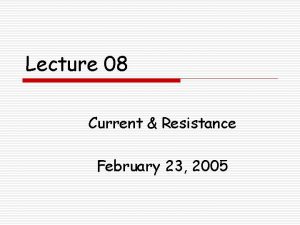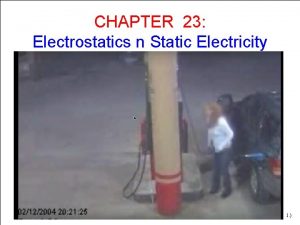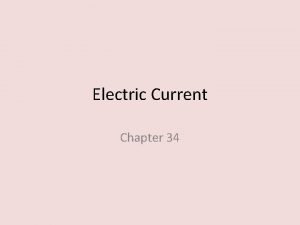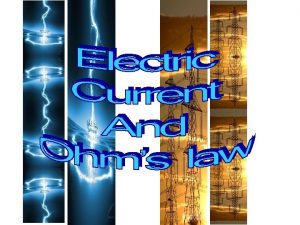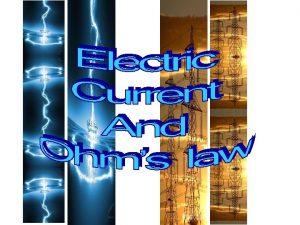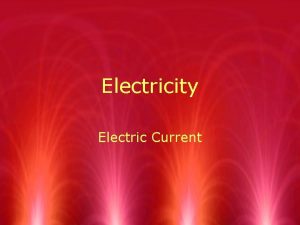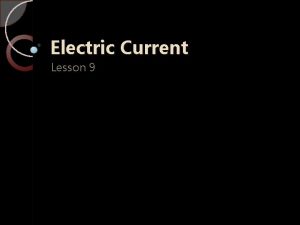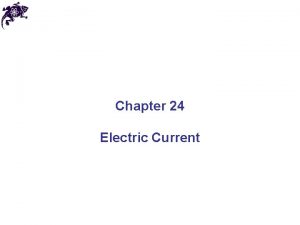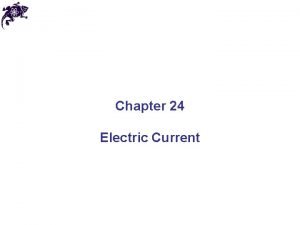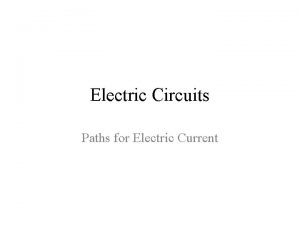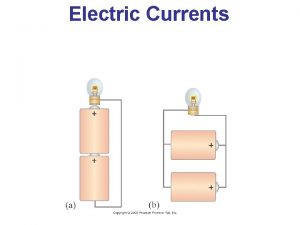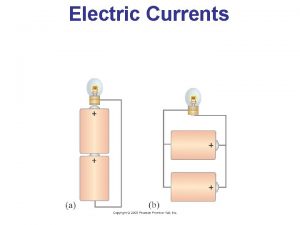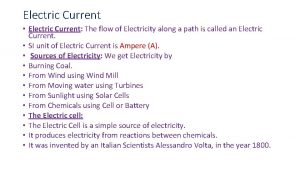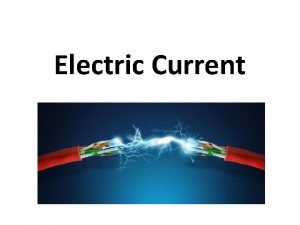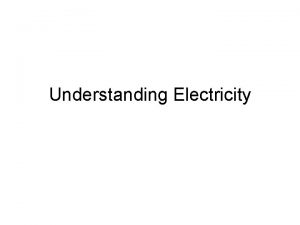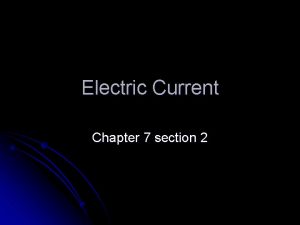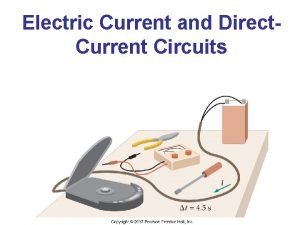Electric Current Chapter 2 Section 2 Flow of


















- Slides: 18

Electric Current Chapter 2, Section 2

Flow of Electric Charges • Lightning – Large amounts of electrical energy • Can’t use to power electrical devices – Tvs, radios, clocks, etc. • Only lasts for an instant • Devices need charges that flow constantly

What is Electrical Current? • Electric current – Electric current: continuous flow of electric charges through a material • Charges made to flow through wire or similar material • Static electric charges don’t flow continuously – Rate of electric current – amount of charge passing through a wire in a unit of time • Ampere, amp (A) – unit of electric charge • Describes amount of charges flowing past a given point in 1 second – Electric current – similar to tomatoes on conveyor belt » Move in confined path » More tomatoes pass worker if increase flow » More charges move past point if current increases

Current in a Circuit • To produce electric current, charges must flow continuously from one place to another – Electric current doesn’t automatically exist in materials • Requires specific path to follow – Complete electric circuits – charges flow continuously • Break circuit – charges can’t flow – Circuits all around • Toasters, radios, televisions, etc.

Conductors & Insulators • A conductor transfers electric charge well. – Charges flow easily in circuit made of metal wire • An insulator does not transfer electric charge well – Charges do not flow easily through every material • Plastic wires

Conductors • Conductor: material through which charge can flow easily – Good conductors: silver, copper, aluminum, iron • Electrons easily move through conductors – Loosely bound to atoms • As electrons flow – form electric current – Conductors used to carry electric chrage – Electrons are always present in conductors • You don’t have to wait for electricity to be sent to you – Flip switch – electrons pushed and pulled – Continuous flow of electrons as soon as circuit is completed

Insulators • Insulator: material through which charges cannot flow easily – Good insulators: rubber, glass, sand, plastic, wood • Electrons do not move easily through insulators – Bound tightly to atoms • Insulators stop the flow of charges – Rubber coating on appliance cords • Cord carries charges from outlet to appliance – Inner wire is conductor for current – Rubber coating around wire is insulator keeps charges from you

Voltage • Electric charges flow in a similar way that roller coaster cars move on track

Charges need Energy to Flow • Roller coaster cars need energy to give you a ride – No energy when you climb aboard • Motor provides energy to move a chain attached to cars • Chain pulls cars to the top of the hill gaining potential energy – Potential energy: energy object has due to position, height – Higher cars go, more potential energy they have • Cars rush down hill from area of high potential energy to low – Difference in potential energy between top of the hill and bottom allow cars to move

Charges need Energy to Flow • Charges in electric circuit flow because of potential energy difference • Roller coaster – Cars = Charges making up current – Steel track = circuit – Motor = energy source, i. e. battery • Higher motor takes the cars, the faster they move • Higher the difference between charges, terminals, faster charges move

Voltage • Voltage: difference in electrical potential energy between two places in a circuit (potential difference) – Volt, (V) – unit of measure for voltage – Voltage causes a current in an electric circuit • Like a force pushing an electric current

Voltage Sources • Voltage source: device that creates potential difference in an electrical circuit – Batteries and generators • Two terminals – Voltage between terminals cause charges to move around circuit

Resistance • Roller coaster analogy – Rusty wheels on the roller coaster • Slow cars down because wheel don’t turn well – Similar to current in a circuit

Current Depends on Resistance • Current depends on resistance (as well) – Resistance: measure of how difficult it is for charges to flow through material • The greater the resistance the less current there is for a given voltage • Ohm, (Ω – capital letter omega), unit to measure resistance

Factors that Determine Resistance • Four factors determine resistance – Material that wire is made of • Insulators have high resistance – Electrons tightly bound to atoms and difficult to move • Conductors have low resistance – Electrons loosely bound to atoms and can move easily – Length • Less water flows through longer pipes because it bumps into the inside wall more • Relationship between length and resistance – As length increases, electrical resistance increases

Factors that Determine Resistance • Four factors determine resistance – Diameter • Less water can flow through smaller pipe • Relationship between diameter and resistance – As diameter increases, electrical resistance decreases – Temperature of wire • Relationship between resistance and temperature – As temperature increases, electrical resistance increases – As temperature decreases, electrical resistance decreases

Path of Least Resistance • Person told “taking the path of least resistance” – Person is doing something the easiest way possible – If electric charge has a choice to flow through two paths • More electric charge flows through path with lower resistance – Bird perched on uninsulated wire • Bird isn’t hurt • Charges flow through path of least resistance – Bird’s body more resistance than wire

Homework • Read Chapter 2, Section 2, p 44 -51 • Answer ? s 1 -4, p 51
 Chapter 23 electric current circuit happenings
Chapter 23 electric current circuit happenings Conceptual physics chapter 23 electric current
Conceptual physics chapter 23 electric current Chapter 34 electric current
Chapter 34 electric current Chapter 21 electric charge and electric field
Chapter 21 electric charge and electric field Chapter 21 electric charge and electric field
Chapter 21 electric charge and electric field Coulombs constant units
Coulombs constant units Units of a charge
Units of a charge Chapter 6 section 1 electric charge worksheet answers
Chapter 6 section 1 electric charge worksheet answers Chapter 17 section 1 electric charge and force answer key
Chapter 17 section 1 electric charge and force answer key A balanced delta connected load having an impedance 20-j15
A balanced delta connected load having an impedance 20-j15 Line vs phase voltage
Line vs phase voltage Energy band diagram of pnp transistor
Energy band diagram of pnp transistor Ac systems lesson 4
Ac systems lesson 4 Drift current
Drift current Ceramic composition resistors
Ceramic composition resistors The constant current region of a fet lies between
The constant current region of a fet lies between Balanced wye wye connection
Balanced wye wye connection Infineon
Infineon Diffusion current formula
Diffusion current formula
